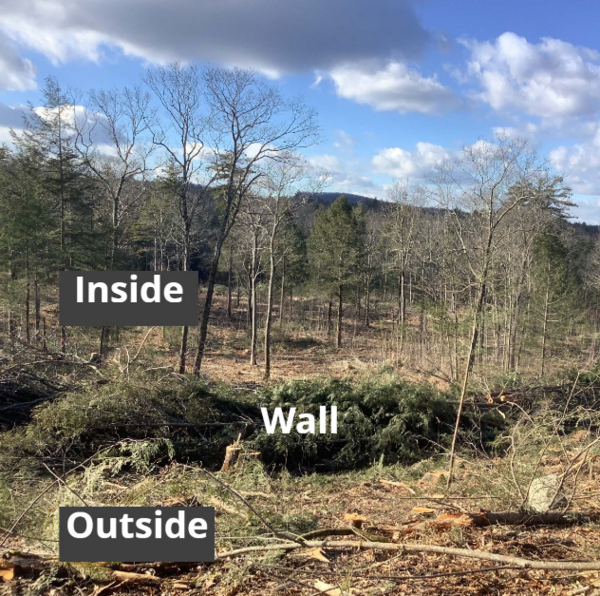Creating Habitat for Threatened Species
Stewardship Manager Tessa Dowling excitedly came into the office last week with the report from her visit to our newly completed forest management project in Warwick: "It's working! There were lots of deer tracks outside the wall and none inside!"
The Song Memorial Forest slash wall project is the second in Massachusetts, the first being built by DCR Division of Water Supply and Protection on public forest in Oakham. First used by the Cornell Department of Natural Resources, walls constructed from remnant logging slash protect areas from deer browsing so they can regenerate into young forests after a harvest. Our goals in this project are to address threats to bird habitat by protecting regenerating oak forests from deer browse, and to collect data from this demonstration area to inform professionals planning future projects.
The slash was surrounds 7 acres and measures approximately 8 ft tall and 20 ft at the base. This innovative project is thanks to the willingness of so many community members and professionals to think outside the box and turn a vision into reality. Our forester, Mike Mauri, especially credits the support of abutting neighbor for use of his log landing, the previous logger Jason Spaulding (and his dad, Warren) for his help making the plan for this project, and our current logger Seth Ellwood for his incredible implementation of this hard-to-envision plan.
Our Stewardship Program is focused on managing the land for a healthy landscape in the face of habitat loss & degradation, development, and climate change. Mount Grace prioritizes land management techniques that will improve biodiversity of plants and wildlife so our conservation areas become more resilient in the face of climate change.
Massachusetts’s Foresters for the Birds program identified Focal Bird Species such as the American woodcock, mourning warbler, chestnut-sided warbler, black-and-white warbler, white-throated sparrow, and eastern towhee. All these species thrive in regenerating young forests and are declining in Massachusetts and greater New England.
Massachusetts is recognized as an important locus for Northeastern migratory breeding birds because it is a part of two major North American ecotypes: the Northern Forest Region and the Eastern Deciduous Forest Region. For many declining species, such as the black-throated blue warbler, the chestnut-sided warbler, and the wood thrush, as much as 90% of their population is breeding in this region. Their declines can be attributed to the current conditions of our forested habitats. Creating and maintaining viable habitat conditions will be instrumental in sustaining healthy populations for our native birds.
Although herbivory is a natural process in forest ecosystems, the current overabundance of deer populations, due to land-use change, reduced hunting pressure, and a loss of keystone predators, can impact the regeneration of young forests. Over browsing has left some forested ecosystems completely altered, structurally and functionally, by selective herbivory. Our slash wall project offers a novel technique to improve the regenerating ability of young forests from overpopulations of deer.
Song Memorial Forest is an 87-acre parcel in Warwick surrounded by a larger forested block of Massachusetts State Forests. A particular challenge to this project was that two timber harvests have been conducted here in the last twenty years, leaving less raw material to work with in building the wall. The DCR slash wall in Oakham, and other walls we’re aware of from conversations with Cornell, have been constructed in areas without a recent history of forest management.
The dominant forested types, eastern hemlock, northern hardwood, and oak-pine, support an array of wildlife, including threated bird populations. Song contains two brooks, connected to the Connecticut River watershed, that support a large wetland and an abandoned beaver pond where flycatchers such as the great-crested flycatcher has been observed. The wetland area has several snags standing in the pond, with softwoods dominating the adjacent uplands. The greater landscape contains wild strawberry carpets, along with goldenrods and many grass and sedge species in the open areas.
We are now engaging community volunteers and local naturalists at this site to collect observations using the citizen science platforms eBird and iNaturalist. With the data from citizen science surveys, we hope to measure the success of slash walls and our invasive removal-native plantings treatments. To learn more and get involved in these citizen science efforts, contact Tessa at dowling@mountgrace.org.
Mike Mauri would also like to credit the folks at Cornell Extension, Peter Smallidge and Brett Chedznoy, for their efforts to conceptualize, implement, and publicize the early stages of the slash wall approach, and to answer my own many specific questions; and retired Quabbin and Ware River Chief Forester Herm Eck, who took tie to show him the slash wall constructed on DCR land in Oakham, which was the first in Massachusetts.

